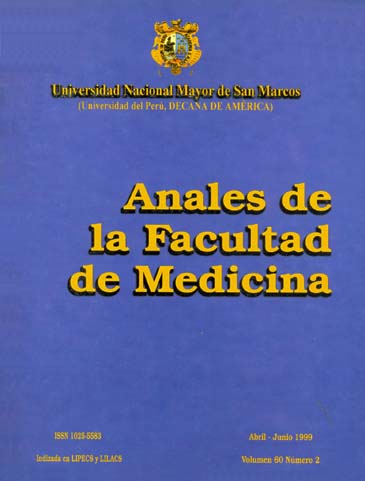Association Between p53 Mutations with Tumoral Size and Dukes’ Stage Among Patients with Colorectal Carcinoma at The Hospital Central Fap, 1987-1996.
DOI:
https://doi.org/10.15381/anales.v60i2.4469Keywords:
Colorectal Neoplasms, Protein p53, ImmunohistochemistryAbstract
OBJECTIVES: To determine the presence of p53 mutations among patients with colorectal carcinoma and their relationship with the tumoral size and with Dukes’ stage classification. MATERIALS AND METHODS: Anatomopathological specimens of 40 cases of colorectal carcinoma from the Hospital Central FAP, taken between 1987 and 1996, were re-examined. For detecting p53 protein mutations, the streptavidin-biotin immunoperoxidase immunohistochemical assay with do-7 antibody was used, pre-processing the samples with microwaves. RESULTS: All cases were adenocarcinomas, mostly moderately differentiated; 18 were in Dukes B, 16 Dukes in C, 4 in Dukes A and 2 in Dukes D stage. Tumoral size was directly related with Dukes’ stage, having a mean size of 5,5 cm3 for Dukes A, and 50,12 cm3 for Dukes D. There was a presence of p53 mutation in 55% of cases; the higher p53 expression, both the higher Dukes’ stage (a = 0,353) and the higher tumoral size (a = 0,376). CONCLUSION: Among our cases, p53 mutation accumulation was directly related with tumoral size and Dukes’ stage.Downloads
Published
1999-06-14
Issue
Section
Trabajos originales
License
Copyright (c) 1999 Nancy Rosas Marroquín, Ebert Torres

This work is licensed under a Creative Commons Attribution-NonCommercial-ShareAlike 4.0 International License.
Those authors who have publications with this magazine accept the following terms:
- Authors will retain their copyrights and guarantee the journal the right of first publication of their work, which will be simultaneously subject to Creative Commons Attribution License that allows third parties to share the work as long as its author and its first publication this magazine are indicated.
- Authors may adopt other non-exclusive licensing agreements for the distribution of the version of the published work (eg, deposit it in an institutional electronic file or publish it in a monographic volume) provided that the initial publication in this magazine is indicated.
- Authors are allowed and recommended to disseminate their work over the Internet (eg: in institutional telematic archives or on their website) before and during the submission process, which It can produce interesting exchanges and increase quotes from the published work. (See El efecto del acceso abierto ).
How to Cite
1.
Rosas Marroquín N, Torres E. Association Between p53 Mutations with Tumoral Size and Dukes’ Stage Among Patients with Colorectal Carcinoma at The Hospital Central Fap, 1987-1996. An Fac med [Internet]. 1999 Jun. 14 [cited 2024 Jul. 17];60(2):85-92. Available from: https://revistasinvestigacion.unmsm.edu.pe/index.php/anales/article/view/4469















